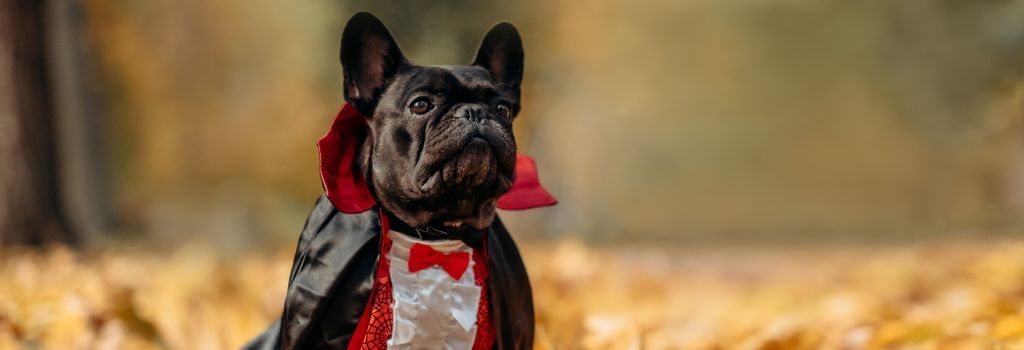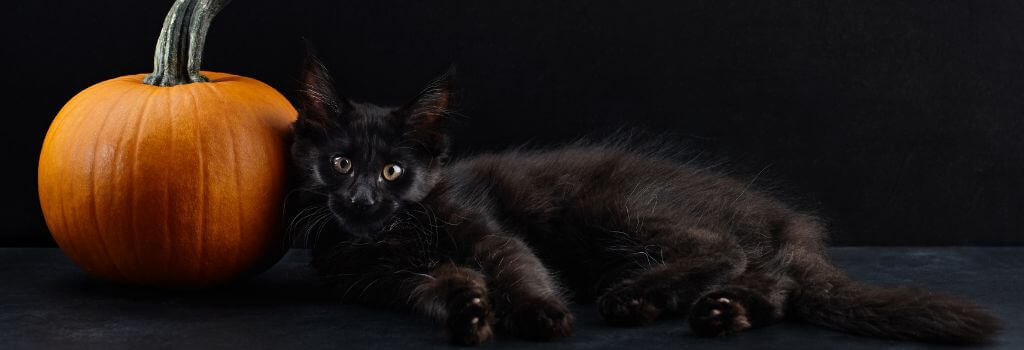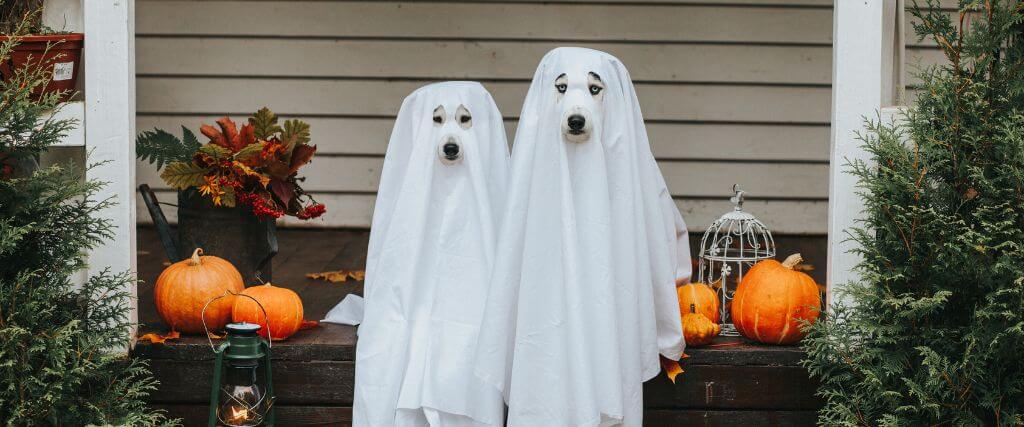From vampurrs to dogosaurs, there are few things as irresistible as a pet dressed up for Halloween. In fact, surveys show that nearly one in five pet owners plan to dress their pets in costumes each year, and spending on pet apparel, like Halloween costumes for pets, in the U.S. has skyrocketed, climbing from a few hundred million dollars a decade ago to an estimated $700 million in 2024.
Whether you’re planning on hanging out at home, going trick-or-treating door-to-door, or hitting up a local trunk-or-treat event, thinking ahead about how to safely include your pet in the festivities is a great way to make sure they enjoy the holiday as much as you do. Halloween safety for pets starts with their costume, and making sure it’s as safe as it is spooky. Our top Halloween pet safety tips below will help you choose the right costume for your pet and keep them comfortable and frighteningly cute.
Find The Right Fit
First things first: make sure your pet’s costume fits properly and comfortably. When choosing a Halloween costume for dogs or cats, the costume’s fit is just as important as its cuteness or spookiness factor. Pet Halloween costumes should always be comfortable, well-fitting, and free from any accessories or components that can drag or get tangled, easily removed from the costume, or chewed on or ingested.
When choosing your pet’s Halloween costume, be sure to prioritize the following:
- Proper Sizing – The costume should neither be too tight nor too loose. A snug fit prevents the material from slipping, tangling, or getting caught on furniture. Avoid tightness around the chest, neck, or belly that can restrict breathing, circulation, or movement.
- Unrestricted Movement – Pets should be able to walk, run, sit, and lie down naturally while wearing the costume. Restrictive outfits can cause stress, trips, or falls, especially for dogs going on walks or cats trying to jump. If your pet is active – or even clumsy – consider something simpler to avoid any accidents.
- Open Airways, Clear Vision, and Accessible “Exits” – Masks, hoods, or hats that cover the nose, mouth, or eyes should be avoided. A safe pet costume will never interfere with a pet’s ability to see, hear, pant, or potty.

Keep It Simple
When it comes to pet Halloween costumes, simple is usually better — and safer. Elaborate pet costumes with multiple layers, long tails, or lots of dangling accessories are cute in theory, but they pose several real risks to your pet and should be avoided if possible.
Loose parts and draping fabrics can easily catch on furniture, doors, or outdoor obstacles, putting your pet at risk for trips, falls, and other injuries. Small attachments or decorations like buttons, beads, or sequins can also be chewed off and swallowed, creating a choking hazard or risk of intestinal blockage – things that I’m sure every pet owner would prefer to avoid.
If you plan to take your dog or cat trick-or-treating, it’s important to consider visibility as well. A costume that blends into the night can make your pet hard to see, especially if you’ll be walking near streets with traffic or in dimly lit areas. Bright colors, reflective strips, or LED collars and harnesses can make your pet easier to spot and help keep them safe from cars, wildlife, and other pets out trick-or-treating.
Make It Age-Appropriate
Making sure costumes are age-appropriate isn’t just for parents with kids; pet parents should be doing this, too! Dogs and cats at different age levels will have different needs and preferences when it comes to costumes. Puppies and kittens, for example, are notorious chewers, so pet owners who want to dress their new furry friend up for their first Halloween will need to choose something that can’t be easily removed, chewed on, or ingested.
Additionally, costumes can be stressful – and painful – for some senior pets. Older dogs and cats often have age-related issues like arthritis, reduced mobility, vision loss, or hearing decline, all of which can make bulky or restrictive costumes uncomfortable and disorienting. Some senior pets are also starting to slow down and lose some of their energy, so what seems like a short photo session in costume to you may feel exhausting to them. Try to look for lightweight, easy-on/easy-off options that don’t require much handling, like a fun seasonal sweater, cape, or soft slip-on accessory. We’re sure your senior pet will be appreciative of something more lowkey!
Know Your Pet’s Level of Costume Comfort
Some pets don’t mind humoring their humans on Halloween; others, not so much. If you want to dress up your pet for Halloween, be realistic and choose a costume that is suitable for their preferences. If your dog or cat can’t stand wearing sweaters or shirts during other seasons, they probably won’t be too thrilled about a full Halloween costume, and it may be a better idea to pick out some pet-safe accessories for them.
If your pet is apprehensive or wearing clothes or costumes, it’s a good idea to help them warm up to their outfit before Halloween night. Let your pet get comfortable with their costume by trying it on early and often — several times before the big night, if possible. Then watch carefully for clues of discomfort, from pinned ears or a tucked tail to pawing, shaking, scratching, running, freezing, or hiding. The bottom line: If your pet seems distressed in a costume, don’t force it and respect their level of comfort.
If your pet has a medical condition that makes dressing up especially difficult, consider skipping the full costume and opting instead for a seasonal bandana, bow tie, or themed collar. This way, your pet can still join in the fun without added stress or discomfort.

Don’t Forget Collars & ID Tags
No pet costume is complete without a collar, leash, and ID tags. Whether your pet is accompanying the kids for a spooky stroll around the block or greeting the neighborhood ghosts at home, it’s always better to be safe than sorry. Before the festivities begin, take a moment to make sure your pet can wear their collar and leash comfortably in costume, their ID tags are secure, and your microchip information is up to date, just in case.
Make the Costume Appropriate for the Weather
I’m sure many of us can remember Halloweens from our childhoods where we were either sweating or freezing because our costumes were probably not the most appropriate for the weather. So, if you plan to bring your pet outside at all on Halloween, be sure to factor in what the weather will be like in your area when deciding on their costume!
For Warm Weather: Heavy or layered costumes can quickly cause pets to overheat, especially brachycephalic breeds like pugs, bulldogs, and Persian cats, who already struggle with regulating temperature. If you live in a warmer climate or expect a hot Halloween, stick to lightweight, breathable fabrics and avoid full-body costumes that will trap heat against your pet’s body. Simple options like collars or bandanas are better options for areas that have warmer Fall weather. In addition to keeping the weather in mind when planning for a pet Halloween costume, always watch for signs of overheating, like panting, drooling, or lethargy.
For Cold Weather: On the flip side, if you live somewhere chilly, a costume can actually double as an extra layer of warmth! Look for soft, insulated outfits that cover your pet’s chest and back without being restrictive. Sweater-style costumes or fleece-lined options can be especially comfortable for short-haired breeds or senior pets who may be more sensitive to the cold. Just be sure the fit is right so your pet can still walk and move freely.
Bonus Pet Halloween Safety Tip: Always Watch Your Pet!
It can be easy to get swept up in the fun and festivities of Halloween, but if you’re including your pet in your celebration, you’ll need to be sure that they are supervised at all times. Accidents and emergencies can happen in the blink of an eye.
If you have to leave your pet alone for any reason on Halloween, make sure they are safe inside your home with all of the doors and windows closed and locked to avoid an accidental escape in the event that they get frightened. And be sure to take their costume off and store it somewhere safe before you go – this can go a long way in preventing them from getting stuck on something, overheating, choking, or getting into any mischief!
If you have questions and you'd like to reach out to us, you can call us directly at (201) 350-1802, or you can email us at [email protected]. Don't forget to follow us on social media Facebook, Instagram.

